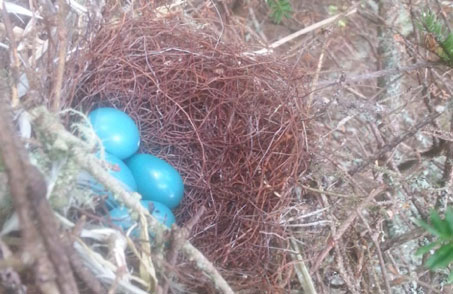Fundy Field Notes- Lets Get Cracking

By Regan Maloney Catbird nest from Bon Portage Island, Nova Scotia
What is the first thing you think about when someone mentions egg shells? Do you think about how you try to avoid getting any in your cake batter and yet always have to fish some out, or do you think about how our early ancestors were freed of the restraints of water 300 million years ago? Personally, I usually think of how one tiny piece of shell always makes it into my cake batter… but that’s not what we will talk about today.
Nova Scotia plays an important part in the history of eggshells. The very first known creature to lay an egg on land with hard shell (amniotic egg), was Hylonomous lyelli. Hylonomous was discovered inside a fossil tree trunk in the fossil cliffs of Joggins, Nova Scotia and lived approximately 315 million years ago. The ancestors of Hylonomous were amphibians and had to lay eggs in water. This tethered its ancestors to the water and prevented them from exploring too far away from it. The top predators of the era were also amphibians and were similarly constrained by their proximity to water. Hylonomous gained a huge advantage in avoiding being eaten by being able to lay eggs farther from water. Hylonomous is the very first known amniote, a diverse group that today includes reptiles, birds, and mammals. Amniotes thrived by adapting to the vast ecological niches available on land. It’s a little ironic that some amniotes (like whales) then evolved back to an aquatic life. Evolution is complicated…more on that next week.
An amniotic egg is like a little spaceship, it needs to be self-sufficient. Everything needed for the embryo to survive needs to be inside the egg. It needs to be packed with all the food the embryo needs, which is called the yolk! It also needs to be able to store the waste produced by the embryo as it grows and prevent it from contaminating the embryo. Imagine how messy things would get on a spaceship where waste wasn’t contained…In the last 315 million years, egg-shells have diversified to extraordinary lengths. Eggs can come in multiple colours, shapes, and sizes. Have you ever seen a green chicken egg (besides in a Dr.Seuss book)? There are also electric blue catbird eggs, spherical sea turtle eggs, oblong therapod dinosaur eggs and so many more variations.

We haven’t even cracked the surface of all the ways that eggs are amazing. Hopefully this has started to get you thinking a little bit more about the deeper story behind the omelet or quiche… more about quiche in a future blog, stay tuned.
About the author- Regan Maloney has worked at the Fundy Geological Museum for close to four years. While a student at Acadia University she worked at the Joggins Fossil Centre and has been hooked on fossils ever since. In her free time, she can often be found looking for rocks and fossils… she also enjoys hiking, running, baking, and a good bonfire.